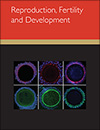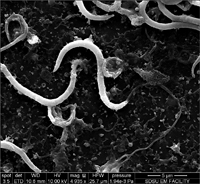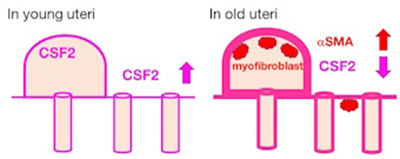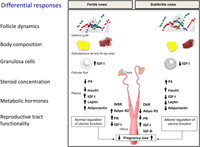Reproduction, Fertility and Development
Volume 37
Number 4 2025
In the past decade, flow cytometry has emerged as a crucial tool for assessing cellular viability in non-domestic animals, including non-human primates, marine life, and birds. Its application in sperm-quality assessments could revolutionize how we evaluate sperm concentration and viability, enhancing efficiency and reliability. This study validated the effectiveness of flow cytometry in assessing amphibian sperm, demonstrating its viability when compared with traditional, time-consuming methods. Such advancements highlight the potential of flow cytometry to significantly streamline conservation efforts for amphibians. Photograph by Ingrid Niesman, SDSU EM Facility.
To clarify mechanisms of age-related infertility, we evaluated the decreased expression of CSF2, one of the most extensively studied embryokines, in aged bovine uteri compared to young ones. We observed suppressed CSF2 expression and increased myofibroblasts, which may contribute to fibrosis, in the uterine epithelium of older cows compared to young heifers. These findings suggest that decreased CSF2 alongside fibrosis may play crucial roles in age-related infertility, opening avenues for further research into potential therapies targeting fibrosis in reproductive health. Image by Hiroya Kadokawa.
Exercise is suggested to have a beneficial role in improving the declining fecundity in humans, which is partly due to poor sperm parameters. Literature reports on the benefits of exercise for male reproductive function are, however, equivocal. This review summarises some of the reports and concludes that low-to-moderate intensity exercises, particularly those that do not increase testicular temperature or oxidative stress, are beneficial to male reproductive function. Image by authors
Subfertile cows that get pregnant late in the breeding season are less productive. We found that fertile cows had more fat and muscle, greater circulating concentrations of metabolic hormones, healthy follicles with more granulosa cells and higher insulin-like growth factor 1 in the follicular fluid. Fertile cows had fewer circulating concentrations of progesterone but the sensitivity of the endometrium to progesterone and adiponectin was greater than in subfertile cows. Fertility was associated to the cow metabolism, that regulates uterine function to reduce embryo losses. Diagram adapted from Meikle et al. (2018).
This article belongs to the collection: The biology of the ovary – Honouring the contributions of Ken P McNatty and Rex J Scaramuzzi.









